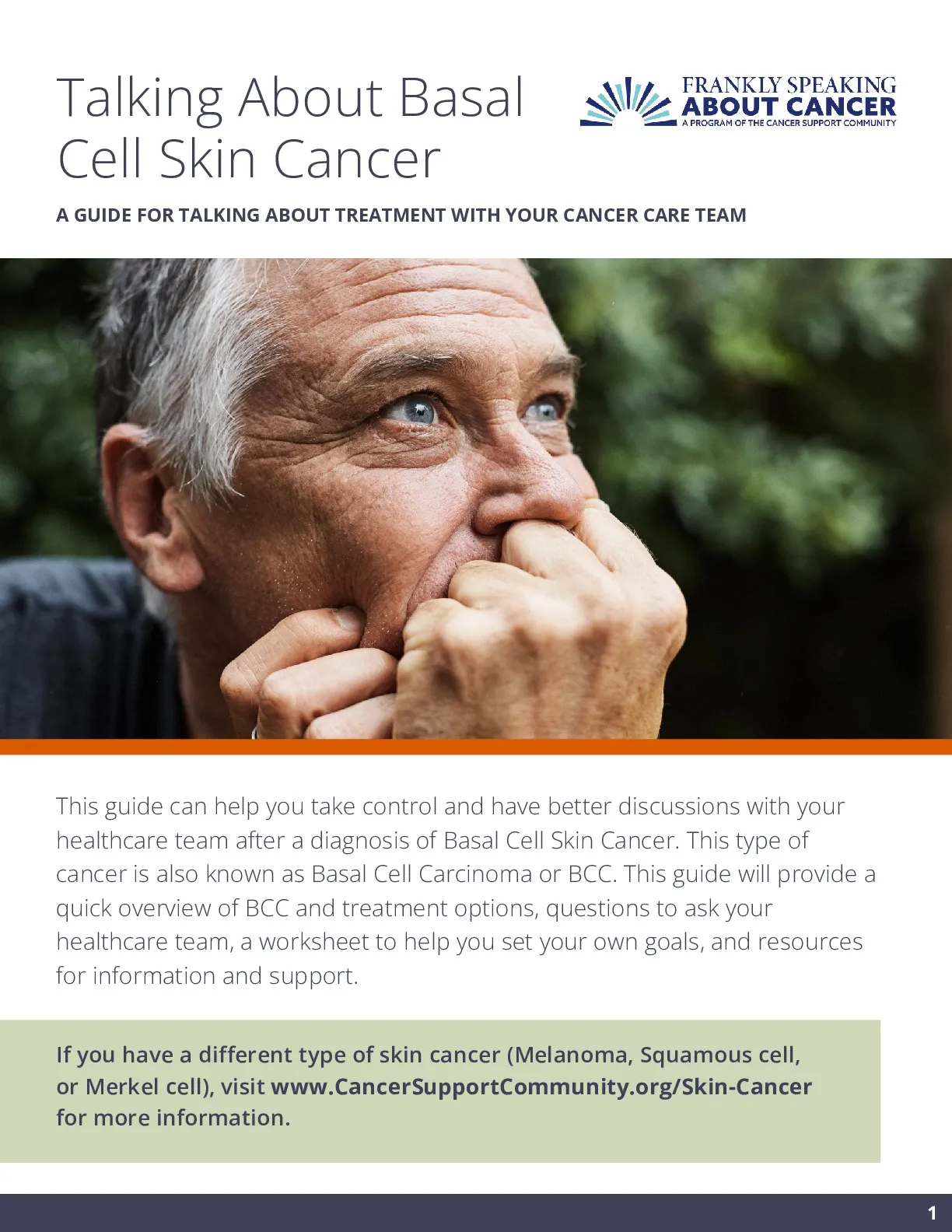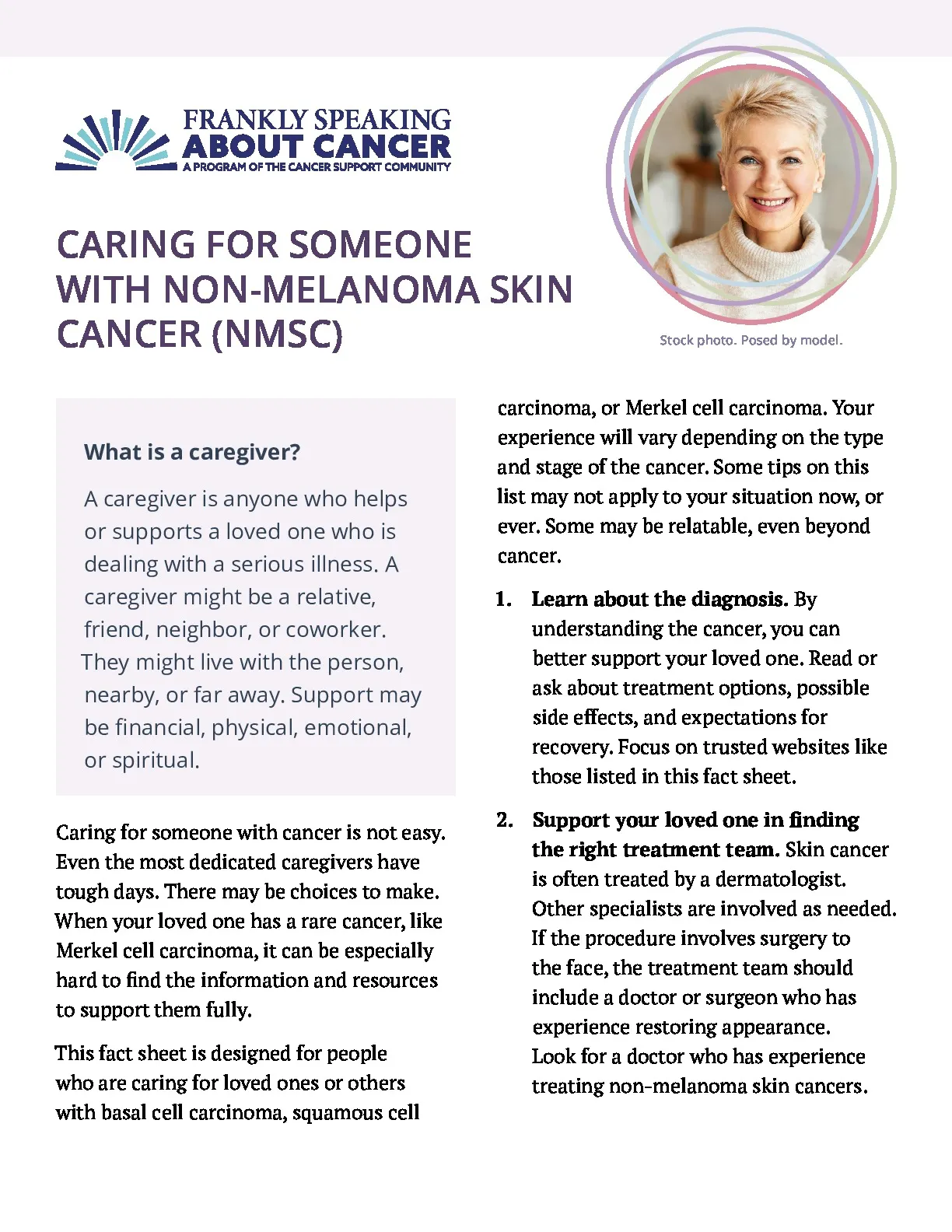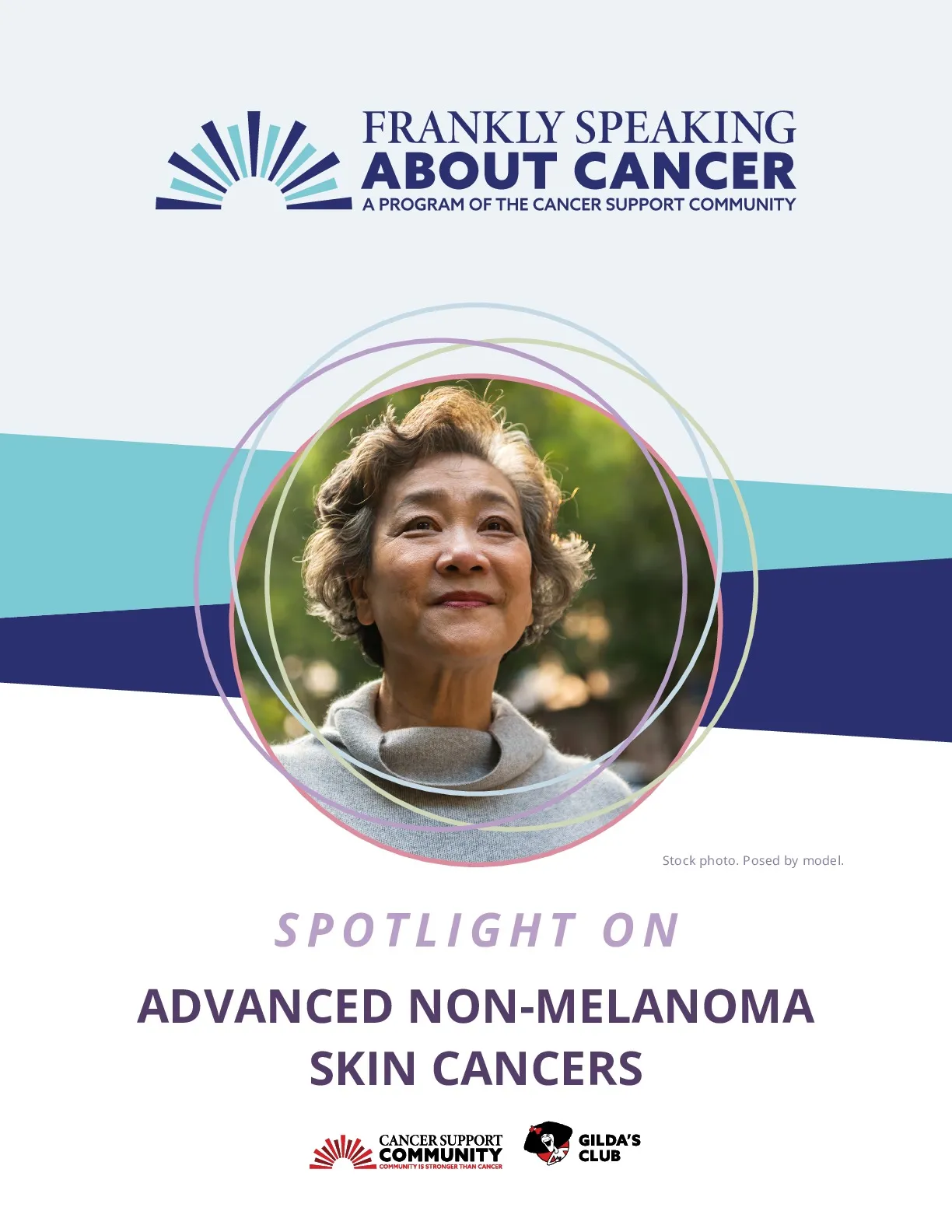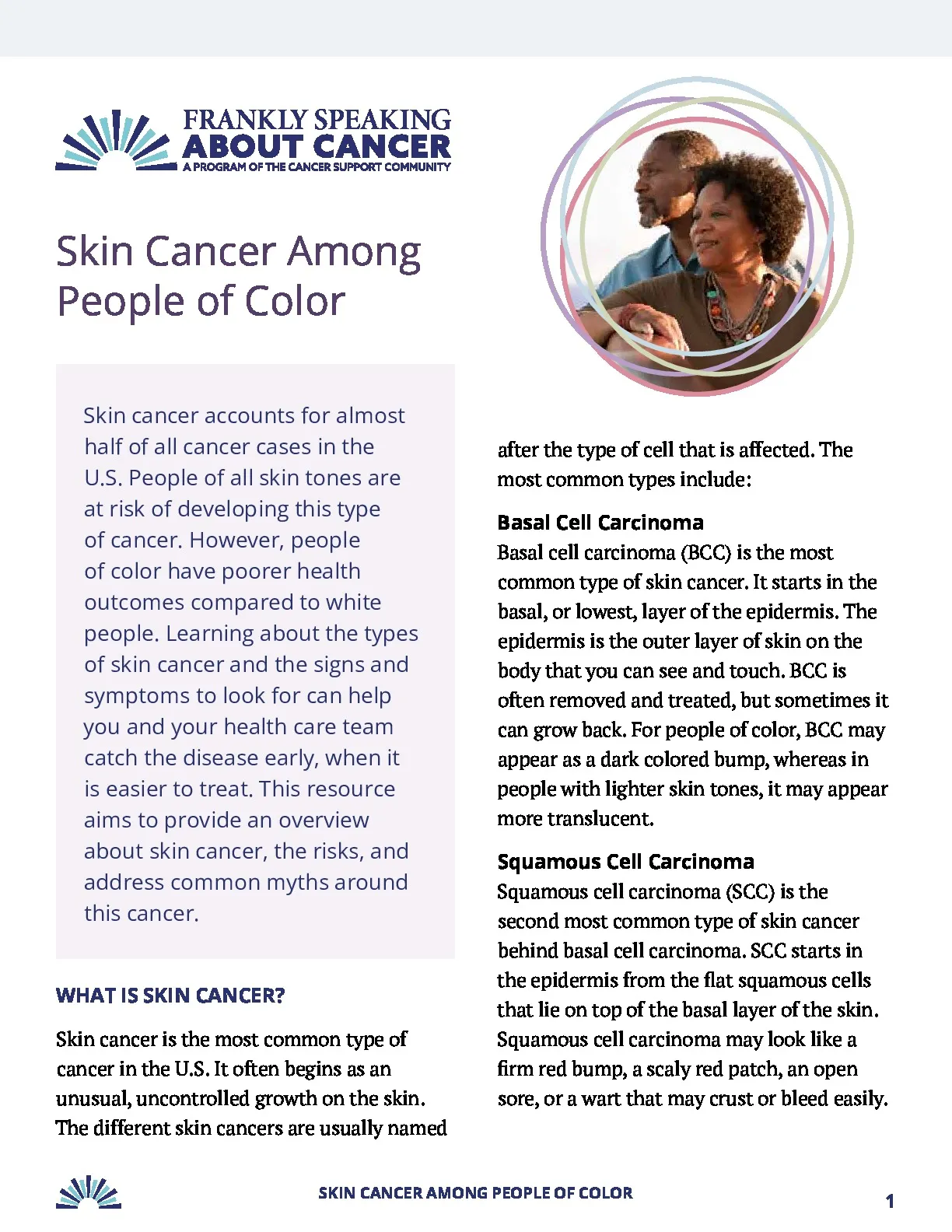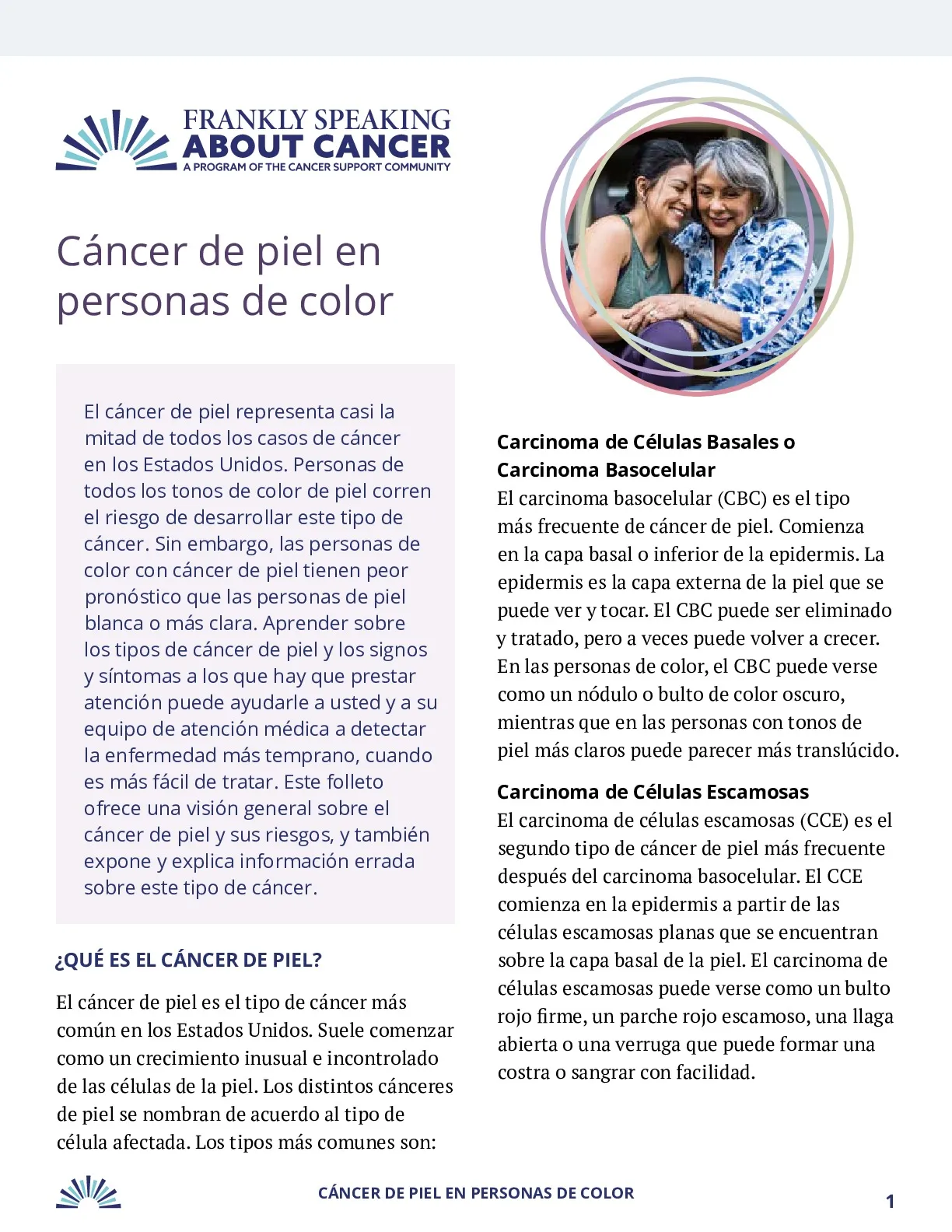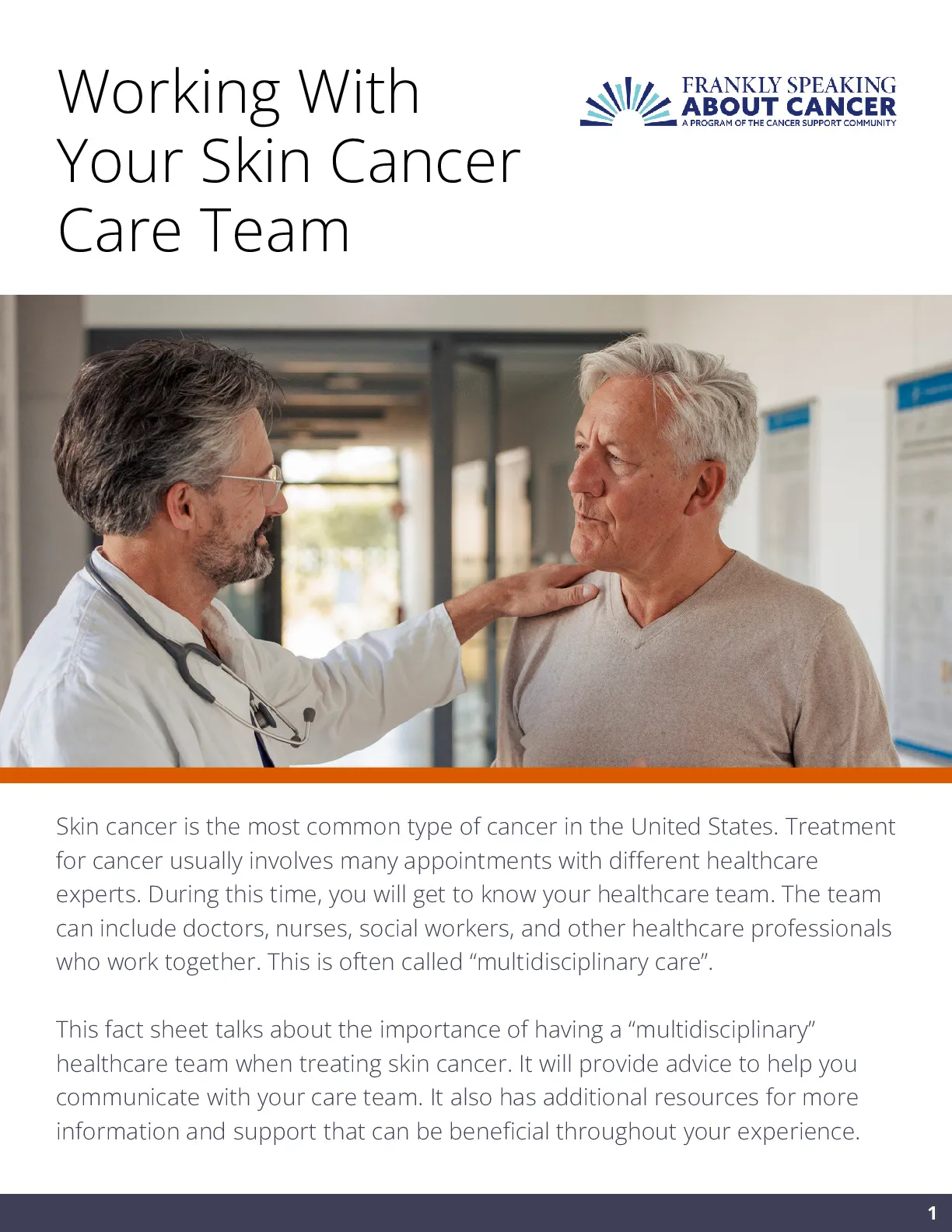Basal Cell Carcinoma
Table of Contents
Basal cell carcinoma (BCC) is the most common type of skin cancer. It starts in the basal, or lowest, layer of the epidermis. The epidermis is the outer layer of skin on the body that you can see and touch. This type of cancer often develops on sun-exposed areas like the face, head, and neck. Still, it can be found on all parts of the body.
BCC usually grows slowly. Because of this, it is often found early and treated. BCC rarely spreads to other areas of the body, becoming advanced stage cancer. If the cancer is left untreated or not removed completely, it may come back (recurrence) or begin to spread to nearby areas.
It is very important to pay attention to sun safety. Here are some tips to make sure you and your family are staying safe:
- Avoid being in the sun during peak daylight hours.
- Always apply (and reapply) sunscreen.
- Wear protective clothing, sunglasses, and wide-brimmed hats.
- Talk to your family and friends about the importance of skin cancer prevention.
- See your dermatologist regularly for skin exams.
- Pay close attention to any sores or bumps that might develop on your skin.
- Try to do regular skin self-exams. Make a date with your partner to check areas you can’t see like your back, scalp back of your legs or buttocks.
Often, you first notice BCC as a lesion on the skin that you think should heal in a week or two. However, one month later it is still there, getting red, raw, and irritated. If lesions do not resolve on their own, they need to be examined by a board-certified dermatologist.

New: Talking About Basal Cell Skin Cancer
Use our short guide to have better discussion with your cancer care team about treatment.
Risk Factors
Certain people are more likely to have basal cell carcinoma (BCC). Some risk factors include:
- Spending too much time in the sun (especially without protection) or using tanning beds
- Frequent sunburns (especially at an early age)
- Fair skin, blond or red hair, and light-colored eyes
- Exposure to industrial compounds (radiation, coal tar, arsenic, other industrial compounds)
- A personal history or previous BCC or other skin cancer
- Family history of skin cancer
- Certain medical conditions or medications (mostly conditions and medications that suppress your immune system)
- Radiation therapy
Very rarely, people can have genetic syndromes where they develop numerous BCCs (>25). The most well-known is called basal cell carcinoma nevus syndrome (BCCNS).
Quick Guide to Advanced Non-Melanoma Skin Cancers
Watch this Quick Guide to Advanced Non-Melanoma Skin Cancer to find out more about the types of non-melanoma skin cancer, diagnosis, staging, treatment, and treatment side effects.
Signs & Symptoms
Basal cell carcinoma (BCC) will look and feel different. The appearance depends on the type it is. There are 6 types: superficial, pigmented, nodular, micronodular, infiltrative, or morpheaform.
Often, you first notice BCC as a lesion on the skin that you think should heal in a week or two. However, one month later it is still there, getting red, raw, and irritated. If lesions do not resolve on their own, they need to be examined by a board-certified dermatologist.
It might appear as a:
- Smooth, shiny, pearly, or waxy bump
- Firm red or flesh-colored bump that grows slowly and may bleed
- Growth with unusual blood vessels in and around it
- Sore that might bleed and doesn’t seem to be healing
- Flat spot or patch of skin (usually red or brown) that is rough, dry, or scaly
- Area of scar-like tissue with no previous procedure done at the site
- Moles that have an uneven shape or surrounding border
For people of color, BCC may appear as a darker bump, whereas in people with lighter skin tones, BCC may appear more translucent.
Regardless of what it looks like, if you notice something on your skin that worries you, or if an existing growth starts to change or irritate you, get it checked out. Try to do regular skin exams, too. Getting comfortable with the look and feel of your skin will help you know what is normal and what’s not.
Screening, Diagnosis & Staging
You know your body best. Check your skin and discuss any changes with your doctor. Your doctor will complete a medical history that will include:
- Your past exposure to the sun
- Any exposure to other known causes of skin cancer
- Your personal or family history of skin conditions
- When you first noticed the mark
- If the mark has changed at all in size or appearance
Tests that are commonly used to find skin cancer include:
Skin exams – A dermatologist (or skin doctor) will check the skin for bumps or spots that look abnormal in color, size, shape, or texture.
Skin biopsy – A biopsy is typically needed to confirm a diagnosis of skin cancer. A biopsy is a common procedure to remove a part of an abnormal-looking growth. The area will be numbed with a local anesthetic injected into the skin. A different doctor (called a pathologist, often a dermatopathologist) will look at this tissue under the microscope to check for cancer cells. There are different types of biopsies that may be used depending on the cancer and its location.
If the disease is more advanced, other diagnostic tests may be added. However, this is done very infrequently.
On rare occasions, a person’s lymph node(s) may be removed to find out if the cancer has spread, which is called metastasis. The doctor may order other tests such as blood tests, chest x-rays, and imaging scans of the lymph nodes and nerves, liver, bones, and brain, but this is rare.
Basal cell carcinoma (BCC) has 3 main categories: low-risk, high-risk, and advanced. Low-risk BCC has a low chance of recurring, whereas high-risk BCC has a greater chance of coming back or recurring. This risk is measured by location, size, and symptoms of the BCC. Advanced BCC is BCC that has spread or metastasized.
Treatment Options and Side Effects
In most cases, BCC is treated using surgery or creams and/or gels applied to the skin. These creams or gels are called topical medications. Treatment depends on the stage of the cancer, the size and location of the tumor, whether or not the lymph nodes are involved, and your preferences. Below is a chart that explains the stages of BCC and the treatment options your healthcare team may recommend.
Surgery
There are several different types of surgical procedures that can be used to remove tissue:
- Excision – The entire tumor is surgically removed along with a surrounding border of healthy tissue.
- Curettage and electrodesiccation (C and E) – the tumor is scraped down to its base followed by pulses of electrical energy. This helps prevent bleeding at the site.
- Mohs surgery – The goal is to remove skin cancer one layer at a time until normal, healthy tissue is reached. After each layer is removed, it is sent to an on-site laboratory to be examined by the surgeon. This allows your dermatologic surgeon to know whether more layers need to be removed in real-time.
- Cryosurgery – Liquid nitrogen is applied to the tumor to freeze and destroy it.
Basal cell carcinoma can invade nearby tissue. If this happens, more tissue will need to be removed, leading to larger scars that some people may find upsetting. That's why it is important to get things checked out early. When found early, they are usually much easier to remove and your surgery site will be smaller.
Possible side effects of surgery may include:
- Pain
- Scarring
- Numbness
- Skin stretching
- Wound problems
- Infection
- Changes in appearance where the surgery was performed
Medications for the Skin
If BCC is “superficial” (in other words, not very deep in the skin), topical therapies creams containing medications (imiquimod or 5-florouracil) can be applied to the skin. Topical therapies are medicated creams or gels that are applied directly to the affected area.
The following side effects are common:
- Pain
- Itching
- Burning
- Irritation
- Inflammation
- Dryness
- Swelling
- Tenderness at the site of application. This will heal once the treatment is complete.
Radiation Therapy
Radiation therapy uses high-powered energy beams to kill or damage cancer cells. Radiation is most often used in patients who cannot undergo surgery for one reason or another. It may also be used in patients who have BCC that has spread to lymph nodes. It may not be recommended for people with BCCNS because they are at higher risk of forming numerous new skin cancers after radiation exposure.
Systemic Treatments
For patients who have had extensive surgeries and can no longer undergo any more procedures because of how advanced the disease is locally and patients with stage IV disease, where the primary tumor is a certain size and can involve local lymph nodes and, rarely, distant metastasis (most often lungs, bones, and liver), other treatments such as
- Chemotherapy: uses drugs to destroy or damage fast-growing cells like cancer
- Targeted therapy: target specific changes in cancer cells that help them grow, divide, and spread. They fight cancer cells with less harm to other cells in the body
- Immunotherapy: works with the body’s immune system to find, attack, and kill cancer cells
- Clinical trials
You may work with a palliative care specialist to address any side effects. Palliative care focuses on improving quality of life and helping to reduce pain and other symptoms. Seeing a palliative care specialist can help address many side effects that may arise during treatment. Palliative care is different from hospice care and end-of-life care. It is available to you at any point of your treatment experience.
Coping
Receiving a cancer diagnosis and going through cancer treatment can be challenging for both patients and their caregivers. It is important that patients work with their care teams to make treatment decisions that best support the patient’s needs and goals. For patients with BCC, their care team may include many different types of doctors. It can be helpful to plan ahead for visits with different specialists.
Patients can prepare by:
- Maintaining a list of all members of the care team and their contact information
- Writing a list of symptoms, side effects, and questions
- Accessing resources and information specific to their diagnosis
- Talking with their loved ones about the support that they need
Side effects of cancer treatment can intensify challenges. Patients and caregivers can work with their care teams to better understand potential side effects. Know that there are steps patients, caregivers, and the health care team can take to help improve the mental and physical well-being.
Frankly Speaking About Cancer Library
LibraryWould you like a print copy of these educational materials?
We can mail our Frankly Speaking About Cancer pieces to you. Shipping is free for up to 20 pounds.
